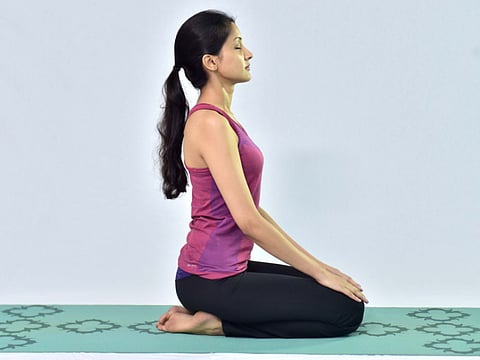Yoga: Lose weight, the natural way – Part 5
Bharat Thakur guides you through the practices of this ancient Indian discipline

The next healthy addition I recommend to weight loss routine is to practise vajrasana (thunderbolt or diamond pose) every day for 30 seconds to two minutes after lunch and dinner. This is the only yoga posture which can be practised immediately after a meal. Let’s understand the significance and correct way of doing this posture.
Vajrasana
Sit on the heels. Overlap the big toes that is place one over the other.
Keep the elbows relaxed with the palms facing down.
Neck remains relaxed with chin in place and back straight. Do not stretch the neck; and keep the chin pointing slightly downwards.
Keep a smile while sitting in this posture. A smile is essential and is called the ananda chitta mudra. Frowning or keeping a tense face can lead to secretion of stress-related hormones in the body.
With eyes closed, inhale, drawing the breath into the navel area with complete awareness, and exhale slowly. Inhalation and exhalation has to be done through the nostrils.
Benefits of vajrasana
The heart pumps blood downwards when the ventricle contracts due to the gravitational pull. That is the reason why people have more headaches than leg aches. While sitting in vajrasana, the blood to the lower body is decreased and directed towards the abdomen. This aids in digestion.
It also helps in relieving haemorrhoids, helps alleviate menstrual problems and other lower abdominal issues.
Yogic texts explain that jatharagni or digestive fire resides in the abdominal area which regulates metabolism. Chakras which can be seen as nerve plexus regulate the entire system of 72,000 nadis (electrical circuits) in the body.
Between the swadisthan chakra (four fingers below the navel) and manipurak chakra (Four fingers above the navel) resides the temperature regulating system which maintains heat in the body and is called khanda. Man’s existence begins at this point as the mother’s umbilical cord is connected here. This is also responsible for many vital functions in the body. In vajrasana, the prana (life force) is channelised towards this area.
Keep in mind
If there is any problem with the knees or ankles such as injuries, ligament issues and the like, please avoid sitting in vajrasana. Instead sit on a chair and practise the breathing described earlier.
If one does a lot of running and sports, stiffness may set into the joints – hips, knees, and ankles. It is important to practise some stretching and breathing in order to relieve the body of this tension and then begin vajrasana.
If the joints are not as flexible, begin vajrasana with a cushion placed under the ankles. If the knees are too tight, place a cushion on the heels and sit on it.
It may take 20-30 days to be able to sit in vajrasana with ease and without any aches and pains.
Practice of the week
Ashwasanchalanasana
Kapotasana
Vajrasana
Next week: Weight loss — the natural way part 6
— This is an interactive series, in which we bring you practical tips on daily living, inspired by the vision of yoga. Write in to tabloid@gulfnews.com with your questions and doubts regarding enhancing your lifestyle through yoga. For more information, call 800-YOGA (9642) or log on to artisticyoga.com
Sign up for the Daily Briefing
Get the latest news and updates straight to your inbox



